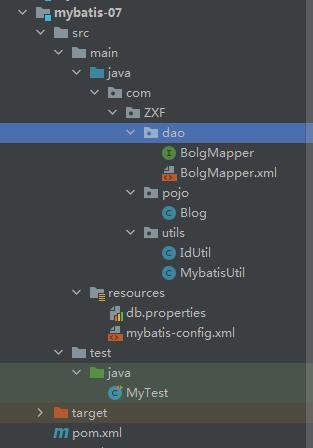mybatis学习笔记-06
Posted 宏远小七
tags:
篇首语:本文由小常识网(cha138.com)小编为大家整理,主要介绍了mybatis学习笔记-06相关的知识,希望对你有一定的参考价值。
mybatis学习笔记-06
这篇文章来写一些动态SQL的方法,也是我自学mybatis的最后一篇文章。
1.动态SQL环境搭建
环境全视图

1.1、 实体类
package com.ZXF.pojo;
import lombok.Data;
import java.util.Date;
@Data
public class Blog {
private String id;
private String title;
private String author;
private Date createTime;
private int views;
}
1.2、 BlogMapper接口
我数据库的表没有数据,所以我在测试环境是否搭建成功的时候,用插入数据来测试。
public interface BolgMapper {
int addBolg(Blog blog);
}
1.3、 BlogMapper.xml配置文件
<insert id="addBolg" parameterType="Blog">
insert into blog (id,title,author,create_time,views)
values (#{id},#{title},#{author},#{createTime},#{views});
</insert>
注意:在这里有一个属性名没有对应,create_time:createTime,这个可以通过mybatis-config.xml核心配置文件中配置
1.4、 mybatis-config.xml核心配置文件
<settings>
<!--是否开启驼峰命名自动映射,即从经典数据库列名 A_COLUMN 映射到经典 Java 属性名 aColumn。-->
<setting name="mapUnderscoreToCamelCase" value="true"/>
</settings>
1.5、唯一的id标识(Idutil)
这次数据库的id我们让UUID类自己生成,待会下一个知识点可能需要自己改,为了学习到更多知识点,麻烦一点都不重要。
import java.util.UUID;
public class IdUtil {
public static String getID(){
//让UUID类生成唯一的id 并将id的-用空来替代
return UUID.randomUUID().toString().replaceAll("-","");
}
}
1.6、 测试
@Test
public void addBlogTest(){
SqlSession sqlSession = MybatisUtil.getSqlSession();
BolgMapper mapper = sqlSession.getMapper(BolgMapper.class);
Blog blog = new Blog();
blog.setId(IdUtil.getID());
blog.setTitle("Mybatis");
blog.setAuthor("小七");
blog.setCreateTime(new Date());
blog.setViews(9999);
mapper.addBolg(blog);
blog.setId(IdUtil.getID());
blog.setTitle("Java");
mapper.addBolg(blog);
blog.setId(IdUtil.getID());
blog.setTitle("Spring");
mapper.addBolg(blog);
blog.setId(IdUtil.getID());
blog.setTitle("微服务");
mapper.addBolg(blog);
sqlSession.commit();
sqlSession.close();
}
2、动态SQL之if语句
- BlogMapper接口
public interface BolgMapper {
List<Blog> queryBlogIF(Map map);
}
- BlogMapper.xml配置文件
<select id="queryBlogIF" parameterType="map" resultType="Blog">
select * from blog where 1=1
<if test="title!=null">
and title=#{title}
</if>
<if test="author!=null">
and author=#{author}
</if>
</select>
- 测试
@Test
public void queryBlogIF(){
SqlSession sqlSession = MybatisUtil.getSqlSession();
BolgMapper mapper = sqlSession.getMapper(BolgMapper.class);
HashMap<Object, Object> map = new HashMap<>();
List<Blog> blogs = mapper.queryBlogIF(map);
for (Blog blog : blogs) {
System.out.println(blog);
}
sqlSession.close();
}
3、choose、when、otherwise
有时候,我们不想使用所有的条件,而只是想从多个条件中选择一个使用。针对这种情况,MyBatis 提供了 choose 元素,它有点像 Java 中的 switch 语句。
用这些元素进行查询:
- BlogMapper接口
public interface BolgMapper {
List<Blog> queryBlogChoose(Map map);
}
- BlogMapper.xml
<select id="queryBlogChoose" resultType="Blog" parameterType="map">
select * from blog
<where>
<choose>
<when test="title != null">
title =#{title}
</when>
<when test="author != null">
and author=#{author}
</when>
<otherwise>
and views=#{views}
</otherwise>
</choose>
</where>
</select>
where 元素只会在子元素返回任何内容的情况下才插入 “WHERE” 子句。而且,若子句的开头为 “AND” 或 “OR”,where 元素也会将它们去除。
- 测试
@Test
public void queryBlogChoose(){
SqlSession sqlSession = MybatisUtil.getSqlSession();
BolgMapper mapper = sqlSession.getMapper(BolgMapper.class);
HashMap<Object, Object> map = new HashMap<>();
map.put("title","Mybatis");
List<Blog> blogs = mapper.queryBlogChoose(map);
for (Blog blog : blogs) {
System.out.println(blog);
}
sqlSession.close();
}
4、trim where set
用这些元素更新blog表:
- BlogMapper接口
public interface BolgMapper {
//更新blog
int updateBlog(Map map);
}
- BlogMapper.xml
<update id="updateBlog" parameterType="map">
update blog
<set>
<if test="title !=null">
title=#{title}
</if>
<if test="author !=null">
author=#{author}
</if>
where id=#{id}
</set>
</update>
- 测试
@Test
public void updateBlog(){
SqlSession sqlSession = MybatisUtil.getSqlSession();
BolgMapper mapper = sqlSession.getMapper(BolgMapper.class);
HashMap<Object, Object> map = new HashMap<>();
map.put("title","java基础");
map.put("id","0b4557c25d0f42d4951da77fb77e9deb");
int i = mapper.updateBlog(map);
sqlSession.commit();
sqlSession.close();
}
set 元素会动态地在行首插入 SET 关键字,并会删掉额外的逗号(这些逗号是在使用条件语句给列赋值时引入的)。
如果 where 元素与你期望的不太一样,你也可以通过自定义 trim 元素来定制 where 元素的功能。这里就写trim的使用方法,因为我觉得用where和set就OK了,如果有需要的话可以看看官方文档。
5、forEach
用forEach查询博客
- BlogMapper接口
public interface BolgMapper {
//查询blog
List<Blog> queryBlogForEach(Map map);
}
- BlogMapper.xml配置文件
<select id="queryBlogForEach" parameterType="map" resultType="Blog">
select * from blog
<where>
<foreach collection="ids" item="id" open="and (" close=")" separator="or">
id=#{id}
</foreach>
</where>
</select>
- 测试
@Test
public void queryBlogForEach(){
SqlSession sqlSession = MybatisUtil.getSqlSession();
BolgMapper mapper = sqlSession.getMapper(BolgMapper.class);
HashMap map = new HashMap();
ArrayList<Integer> ids = new ArrayList<>();
ids.add(1);
ids.add(2);
map.put("ids",ids);
List<Blog> blogs = mapper.queryBlogForEach(map);
for (Blog blog : blogs) {
System.out.println(blog);
}
sqlSession.close();
}
这是我mybatis自学笔记的第6篇,也是最后一篇文章了。没看过我之前的文章的话可以看看,前5篇的链接↓
mybatis学习笔记-05
mybatis学习笔记-04
mybatis学习笔记-03
mybatis学习笔记-02
mybatis学习笔记-01
这一篇是我之前学习JDBC的时候写的笔记,可以对照着mybatis学习一下,看看mybatis为我们做了多少事情。
java JDBC编程学习笔记
本篇文章到这就结束了。自学不易,如果写得不详细,可以结合官方文档看,也可以评论区交流,这篇文章有可以优化的地方希望大佬指教指教。
以上是关于mybatis学习笔记-06的主要内容,如果未能解决你的问题,请参考以下文章